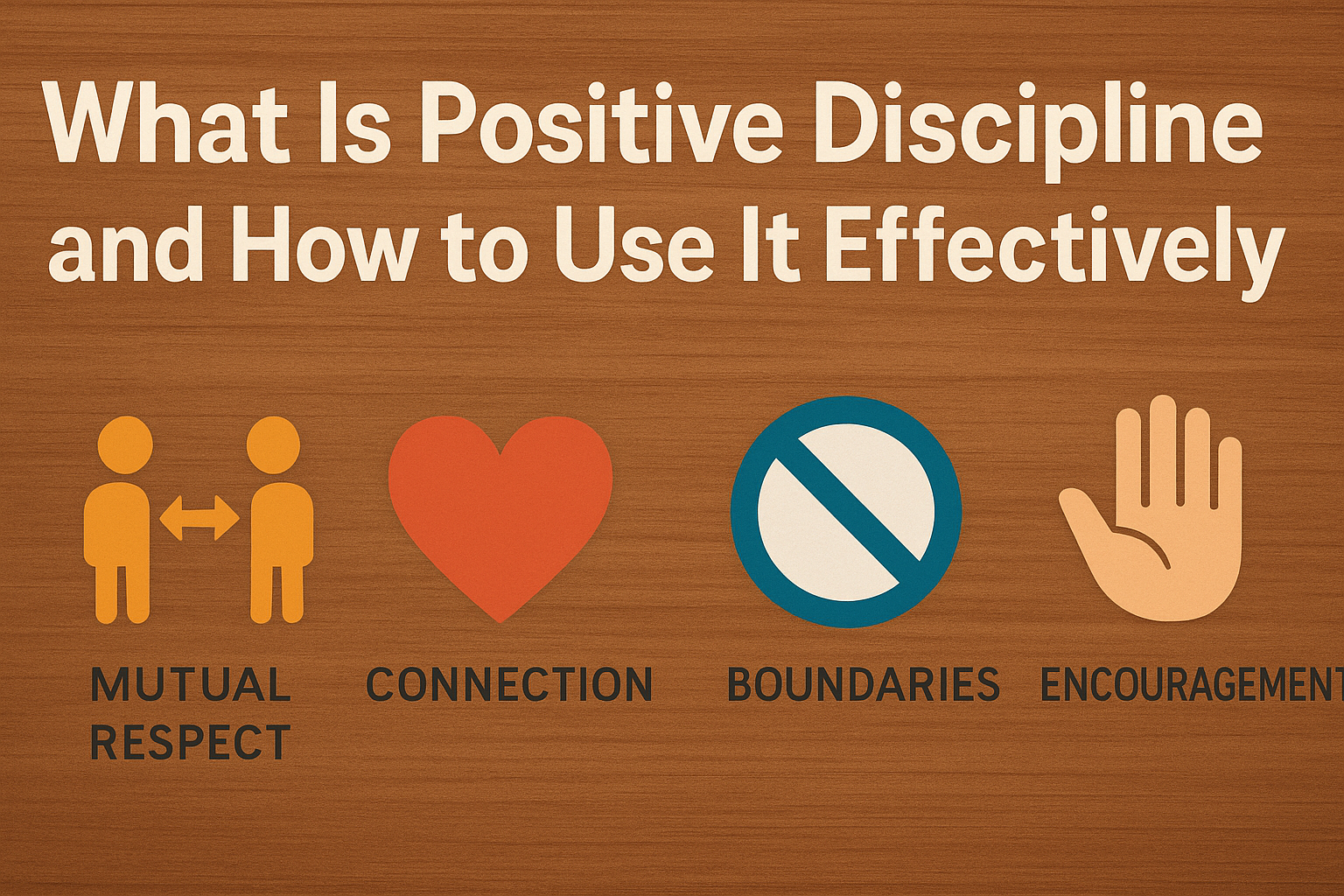Discipline doesn’t have to involve punishment, yelling, or fear. In fact, some of the most effective parenting tools come from an approach called positive discipline—a method based on respect, connection, and teaching instead of controlling.
If you’re looking for ways to guide your child’s behavior while strengthening your relationship with them, this article will walk you through everything you need to know about positive discipline.
What Is Positive Discipline?
Positive discipline is a parenting approach that:
- Teaches children what to do, not just what not to do
- Focuses on connection before correction
- Uses empathy and consistency instead of punishment
- Helps kids develop self-control, responsibility, and respect
Rather than relying on fear, it encourages children to understand consequences and make better choices—because they want to, not because they’re scared.
Key Principles of Positive Discipline
Here are the five main ideas behind this approach:
- Mutual Respect – Treat children with dignity while holding firm boundaries.
- Connection – Behavior improves when children feel seen, heard, and valued.
- Long-Term Goals – Discipline isn’t about obedience today; it’s about raising capable, kind adults.
- Teaching Skills – Focus on building problem-solving, emotional regulation, and empathy.
- Encouragement Over Punishment – Reinforce good behavior instead of punishing mistakes.
Let’s explore how to apply these in everyday parenting.
Discipline vs. Punishment: What’s the Difference?
Discipline means to teach. Punishment means to make suffer.
| Discipline | Punishment |
|---|---|
| Teaches what to do | Focuses on what not to do |
| Builds connection and trust | Damages trust through fear or shame |
| Encourages internal motivation | Relies on external fear or control |
| Promotes problem-solving | Often ends the behavior, but not the cause |
Positive discipline focuses on growth, not guilt.
How to Use Positive Discipline at Home
1. Stay Calm and Centered
You can’t guide your child’s emotions if you’ve lost control of your own.
- Take deep breaths
- Step away if needed
- Speak slowly and calmly
Your calmness helps your child regulate their emotions.
2. Set Clear, Consistent Boundaries
Children need to know what’s expected of them.
- Use simple, firm language: “We use gentle hands.”
- Keep rules consistent across caregivers
- Follow through every time, kindly but firmly
Boundaries provide safety—and when enforced with empathy, they’re even more effective.
3. Focus on Solutions, Not Blame
Instead of “You’re so bad for hitting,” try:
- “What happened?”
- “How do you think your brother felt?”
- “What can we do to make it right?”
- “Next time, what can you do instead?”
This helps children learn accountability without shame.
4. Use Natural and Logical Consequences
Let actions teach the lesson.
- If a child spills milk on purpose → they help clean it up
- If they don’t put toys away → those toys are put away for the day
Make sure consequences are:
- Related to the behavior
- Respectful
- Immediate
- Explained in calm language
Avoid punishments like isolation or yelling, which often backfire emotionally.
5. Use “When-Then” Statements
Structure requests positively:
- “When you finish your homework, then we can play.”
- “When your shoes are on, then we’ll go to the park.”
This avoids power struggles and teaches responsibility in a respectful way.
6. Validate Feelings Before Correcting Behavior
Before setting limits, show your child you understand:
- “I see that you’re frustrated. It’s hard when things don’t go your way.”
- “You’re angry right now. Let’s take some deep breaths.”
Then, guide them toward a better choice.
Empathy doesn’t excuse bad behavior—but it makes children more open to guidance.
7. Encourage Effort, Not Just Outcomes
Positive discipline emphasizes encouragement over praise.
Instead of “You’re so smart,” try:
- “You worked really hard on that puzzle.”
- “I noticed how kind you were with your sister today.”
- “I’m proud of how you calmed down.”
This builds confidence from the inside out.
Common Myths About Positive Discipline
Let’s bust some common misconceptions:
- Myth: It’s too soft.
Positive discipline is both kind and firm. It’s not permissive—it holds clear limits. - Myth: It doesn’t work in tough situations.
It may take longer to see results, but the long-term impact is stronger. - Myth: Kids will walk all over you.
Respect breeds respect. When kids feel respected, they’re more likely to cooperate.
Real-Life Examples
Scenario: Your child refuses to brush their teeth.
Instead of: “If you don’t brush your teeth, no TV!”
Try: “I see you don’t feel like brushing. Do you want to pick your toothbrush or your toothpaste today?”
Scenario: Your child hits a sibling.
Instead of: “Go to your room!”
Try: “It’s okay to be upset, but we don’t hit. Let’s take a break and talk about what happened.”
Positive Discipline Takes Time—But It Works
This approach isn’t about getting quick obedience. It’s about nurturing:
- Self-control
- Confidence
- Problem-solving
- Empathy
- Respect
You’re planting seeds now that will grow into lifelong strengths.
Discipline That Builds, Not Breaks
Parenting with positive discipline doesn’t mean letting your child do whatever they want. It means guiding them with love, patience, and consistency—helping them learn why to behave well, not just how.
You won’t get it right every time. That’s okay. What matters most is your willingness to learn, repair, and try again.
The result? A stronger relationship, a more confident child, and a home built on mutual respect.
